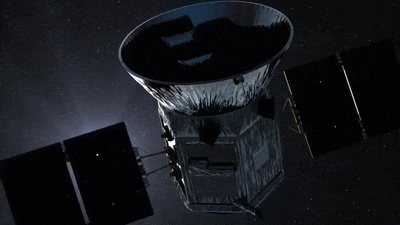Around every star there could be at least one planet, so we’re bound to find one that is rocky, like Earth, and possibly suitable for life. While we’re not quite to the point where we can zoom up and take clear snapshots of the thousands of distant worlds we’ve found outside our solar system, there are ways we can figure out what exoplanets light-years away are made of, and if they have signs of basic building blocks for life. Here are a few missions helping us explore new worlds currently and future.
Kepler: Launched in 2009, the Kepler space telescope searched for planets by looking for telltale dips in a star’s brightness caused by crossing, or transiting, planets. It has confirmed more than 1,000 planets; of these, fewer than 20 are Earth-size (therefore possibly rocky) and in the habitable zone, the area around a star where liquid water could pool on the surface of an orbiting planet. Astronomers using Kepler data found the first Earth-sized planet orbiting in the habitable zone of its star and one in the habitable zone of a sun-like star.
In May 2013, a second pointing wheel on the spacecraft broke, making it not stable enough to continue its original mission. But clever engineers and scientists got to work, and in May 2014, Kepler took on a new job as the K2 mission. K2 continues the search for other worlds but has introduced new opportunities to observe star clusters, young and old stars, active galaxies, and supernovae.
Transiting Exoplanet Survey Satellite (TESS): Launched on April 18, 2018, NASA’s Transiting Exoplanet Survey Satellite (TESS) finds new planets the same way Kepler does, but right in the stellar backyard of our solar system while covering 400 times the sky area. It monitors 200,000 bright, nearby stars for planets, with a focus on finding Earth and Super-Earth-sized planets.
It finds the best targets for follow-up, astronomers can figure out what these planets are made of, and what’s in the atmosphere. One of the ways to look into the atmosphere is through spectroscopy.
As a planet passes between us and its star, a small amount of starlight is absorbed by the gas in the planet’s atmosphere. This leaves telltale chemical fingerprints in the star’s light that astronomers can use to discover the chemical composition of the atmosphere, such as methane, carbon dioxide, or water vapor.
James Webb Space Telescope: Launching in 2021, NASA’s most powerful telescope to date, the James Webb Space Telescope (JWST), will not only be able to search for planets orbiting distant stars, but its near-infrared multi-object spectrograph will also split infrared light into its different colors- spectrum- providing scientists with information about physical properties about an exoplanet’s atmosphere, including temperature, mass, and chemical composition.
Hubble Space Telescope: Hubble Space Telescope is better than ever after 30 years of science, and has found evidence for atmospheres bleeding off exoplanets very close to their stars, and even provided thermal maps of exoplanet atmospheres. Hubble holds the record for finding the farthest exoplanets discovered to date, located 26,000 light-years away in the hub of our Milky Way galaxy.
Chandra X-ray Observatory: Chandra X-ray Observatory can detect exoplanets passing in front of their parent stars. X-ray observations can also help give clues on an exoplanet’s atmosphere and magnetic fields. It has observed an exoplanet that made its star act much older than it actually is.
Spitzer Space Telescope: The Spitzer Space Telescope, formerly the Space Infrared Telescope Facility, is a retired infrared space telescope launched in 2003 and retired on 30 January 2020. Spitzer was the third spacecraft dedicated to infrared astronomy, following IRAS and ISO. It was the first spacecraft to use an earth-trailing orbit, later used by the Kepler planet-finder. Spitzer helps narrow down the sizes of exoplanets and confirmed in 2015 the closest known rocky planet to Earth.
SOFIA: The Stratospheric Observatory for Infrared Astronomy (SOFIA) is an airplane mounted with an infrared telescope that can fly above more than 99 percent of Earth’s atmospheric water vapor. Unlike most space observatories, SOFIA can be routinely upgraded and repaired. It can look at planetary-forming systems and in 2015 observed its first exoplanet transit.




0 Comments